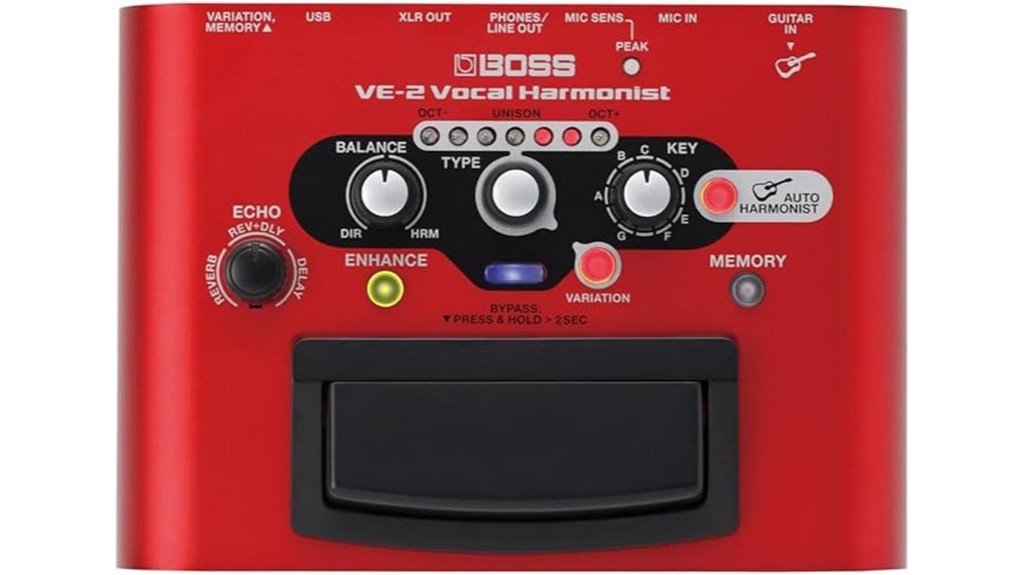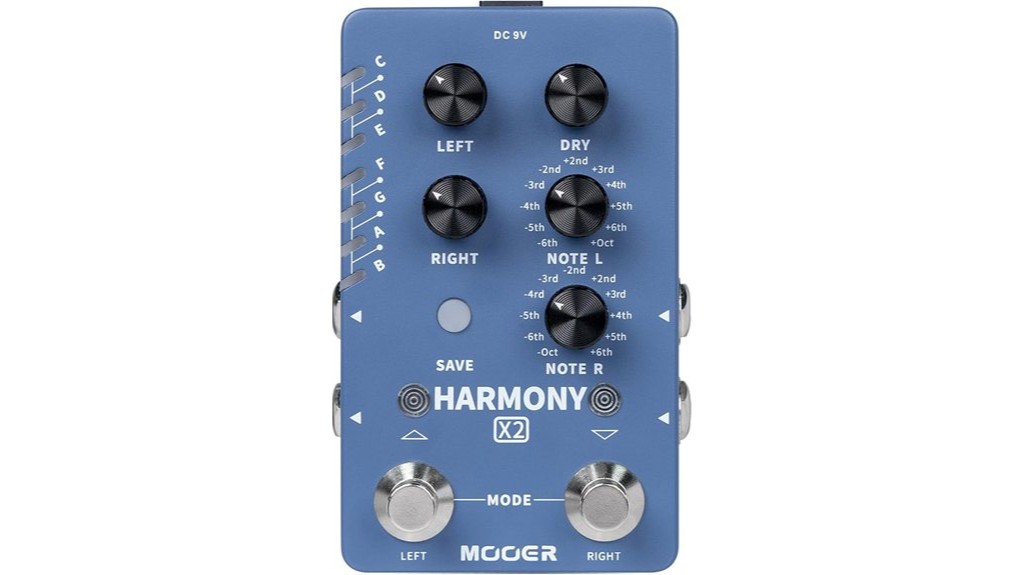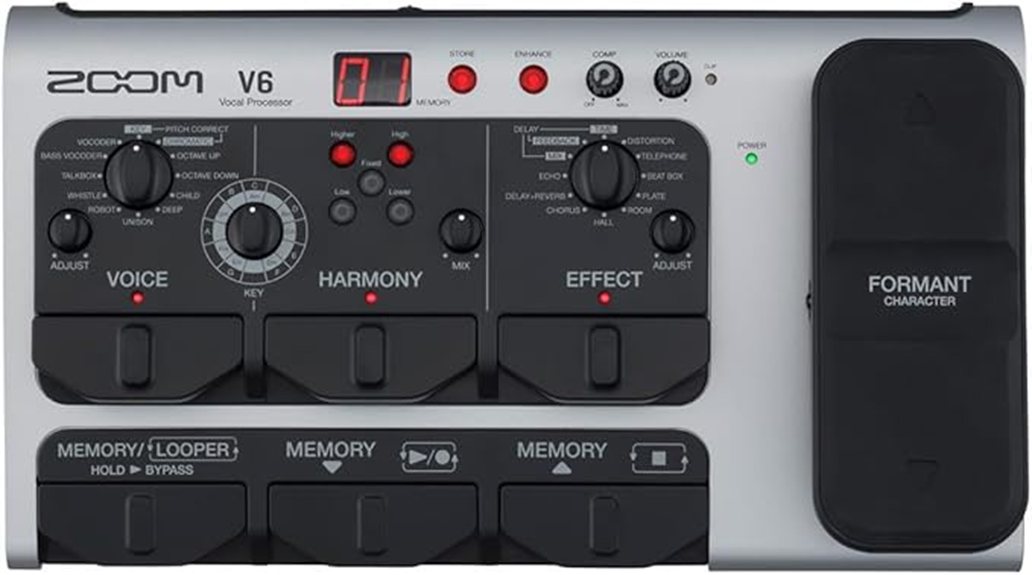This post may contain affiliate links, and we may receive commission if you purchase any of the products listed below.
Let’s explore how we can elevate our live performances with the best harmonizers for vocals. Whether we’re seasoned performers or just starting, finding the right equipment is essential. These top picks offer a balance between quality and user-friendliness. From the rich vocal layers of the Boss VE-2 to the versatile FLAMMA FV04, there’s something for everyone. Ready to discover which harmonizer suits our needs? Let’s plunge into the details.
Boss VE-2 Vocal Harmonist Effects Processor

When you’re searching for the best harmonizers for live vocals, the Boss VE-2 Vocal Harmonist Effects Processor stands out as an excellent choice for solo performers and musicians who crave portability and versatility. This battery-powered device offers 24 harmonies, allowing you to create rich vocal layers using guitar chords. Despite its compact size, it delivers studio-quality reverb and delay. The analog signal format guarantees a natural sound, while the user-friendly design means you don’t need extensive gear knowledge to get started. With the ability to save four settings, it’s perfect for small venues, although some users wish for more memory.
Best For: Solo performers and musicians seeking a portable, user-friendly vocal harmonizer with versatile harmony options and studio-quality effects.
Pros:
- Offers 24 harmonies and uses guitar chords to create rich vocal layers.
- Compact, battery-powered design enhances portability for live performances.
- Studio-quality reverb and delay effects with an easy-to-use interface.
Cons:
- Limited to saving only four settings, which may be restrictive for some users.
- Challenges with foot pedal functionality during live performances.
- No power supply included, only battery operation.
MOOER Harmonizer Guitar Effects Pedal (X2)

The MOOER Harmonizer Guitar Effects Pedal (X2) stands out as a top choice for vocalists and guitarists seeking a versatile and high-quality harmony effect in live performances. With its high-quality stereo harmony effect, you can explore up to 12 pitches in both major and minor modes, offering 11 harmony modes per pitch. You’ll appreciate the dual footswitch control, allowing individual adjustments for dry/wet signals. Its compact design makes it easy to incorporate into your setup. Users love its sound quality, simple operation, and value for money. It’s perfect for home practice, recording, and seamless integration with other Mooer pedals.
Best For: Vocalists and guitarists looking for a versatile, high-quality harmony effect pedal for live performances, home practice, and recording.
Pros:
- High-quality stereo harmony effects with 12 pitches and 11 harmony modes per pitch
- Compact and sturdy design, easy to integrate into setups
- Great value for money with advanced features and ease of use
Cons:
- Some users find the instructions vague, requiring online tutorials
- Requires product registration for downloadable IRs, which may be inconvenient for used purchases
- Limited information available on warranty details without request
TC Helicon HARMONY SINGER Vocal Effects Stompbox

Looking to elevate your live performances with seamless vocal harmonies? The TC Helicon HARMONY SINGER Vocal Effects Stompbox is your go-to tool. It adds up to two voices of realistic harmony, guided by your guitar, ensuring your vocals shine. With three styles of reverb and Adaptive Tone, it optimizes EQ, compression, de-essing, and gating for superior sound quality. Its user-friendly controls mean you’ll be set up in seconds, with options for momentary or latched Harmony modes. Compact and portable, it’s perfect for any setting, integrating effortlessly with your guitar for a professional-grade performance every time.
Best For: Musicians looking to enhance their live performances with seamless vocal harmonies and superior sound quality.
Pros:
- Adds realistic vocal harmony guided by guitar.
- Offers three reverb styles and Adaptive Tone for optimized sound.
- Compact and portable with easy-to-use controls.
Cons:
- Limited to two harmony voices.
- Requires guitar integration for harmony guidance.
- May need additional equipment for full stage setup.
Zoom V6-SP Vocal Processor for Studio and Live Performance

For vocalists seeking versatile and user-friendly harmonizing solutions, the Zoom V6-SP Vocal Processor stands out with its ability to simultaneously handle three vocal processors—voice, harmony, and effects. You’ll appreciate its 100 memory locations for custom patches and the formant shift pedal to adjust vocal character on the fly. With 12 voice effects and over 40 preset patches, there’s plenty to explore.
However, keep in mind that its harmonies might not match competitors like Digitech. It’s compact, but be cautious with the sensitive dials. For best performance, use the recommended Zoom microphone and position it wisely in your setup.
Best For: Vocalists looking for a compact, user-friendly vocal processor with extensive effects options for solo performances.
Pros:
- Compact design with intuitive interface
- Ability to use three vocal processors simultaneously
- Includes 100 memory locations for custom patches
Cons:
- Harmonies may not meet expectations compared to competitors
- Sensitive dials can be difficult to adjust accurately
- Requires a specific microphone for optimal performance
FLAMMA FV04 Vocal Harmony Pedal for Singers and Guitarists

FLAMMA FV04 Vocal Harmony Pedal stands out for vocalists and guitarists seeking to enrich their live performances with robust harmony effects. You’ll appreciate its 11 harmony modes and pitch shifting that seamlessly navigate major and minor scales. The pedal’s dedicated reverb effects enhance both guitar and microphone inputs, supported by 48V phantom power. Its all-metal shell guarantees durability for live use. However, while some users love the reverb and harmonies, others note less effective pitch correction and some noise issues. Despite mixed reviews, it’s a solid choice for newcomers wanting versatile vocal effects in a compact package.
Best For: Vocalists and guitarists, especially beginners, seeking a versatile and compact vocal effects pedal to enhance live performances.
Pros:
- Features 11 harmony modes and pitch shifting for diverse vocal effects.
- Dedicated reverb for both guitar and microphone inputs with 48V phantom power support.
- Durable all-metal shell suitable for live performances.
Cons:
- Pitch correction may not meet the standards of professional auto-tune.
- Users report noise and signal clarity issues with merged outputs.
- Hidden menu navigation can be challenging for some users.
Factors to Consider When Choosing Harmonizers for Live Vocals
When we’re choosing a harmonizer for live vocals, we should consider several key factors to guarantee it fits our needs. Portability and size are essential for easy transport, while sound quality consistency keeps our performance first-rate. Let’s also think about the variety of harmony options, ease of use, and power source flexibility to confirm it suits our style and setup.
Portability and Size
Selecting the right harmonizer for live vocals hinges largely on the portability and size of the device. We need a unit that’s compact, ideally between 5 to 9 inches, to make transportation between venues a breeze. Weighing under 2 pounds guarantees it won’t add unnecessary bulk to our gear. Battery-powered harmonizers offer unmatched flexibility, allowing us to perform without worrying about finding an outlet mid-gig. A smaller footprint on stage means quicker setups and teardowns, which is essential for seamless shifts between performances. Plus, when a harmonizer easily integrates into our existing setup, it helps maintain an organized performance space. Prioritizing these features means we can focus on delivering the best vocal performance, no matter where we’re playing.
Sound Quality Consistency
Although selecting a harmonizer for live vocals involves many considerations, ensuring sound quality consistency stands out as a pivotal factor. It directly influences the clarity and richness of our performances, ensuring harmonies blend seamlessly with the lead vocals. Many vocal processors come with studio-style effects like reverb and delay that enhance sound quality but need careful tweaking to avoid muddiness in live settings. Devices that deliver crisp effects and impressive harmonies are often favorites, especially in small venues. The effectiveness of these harmonizers can depend on the microphone used; we generally recommend dynamic mics for minimizing unwanted noise and ensuring clear vocals. Consistent sound quality is further supported by units with memory settings, allowing us to save configurations for different songs.
Harmony Variety Options
How do we guarantee our live performances are dynamic and engaging? By choosing harmonizers with diverse harmony variety options, we can elevate our vocal arrangements. Let’s look for devices offering 11 or more harmony modes, catering to various musical styles with ease. Major and minor harmony settings are essential, adding depth and complexity to our music. Some harmonizers can create harmonies based on guitar chords, greatly broadening our creative potential. We should select models where we can adjust harmony voices and effects individually, like having control over the dry/wet signal, allowing us to customize our sound. Finally, opting for three-voice harmonizers can enrich vocal textures, providing a fuller and more engaging performance compared to simpler models.
Ease of Use
When choosing harmonizers for live vocals, it’s vital to focus on ease of use to guarantee a smooth performance. We should look for devices with intuitive controls and user-friendly interfaces, ensuring quick setup and operation. Memory settings are a must, allowing us to save and recall configurations effortlessly during shows. This way, we avoid fiddling with controls mid-performance. Pedals offering both momentary and latched modes let us switch harmonies on and off seamlessly, enhancing our flexibility on stage.
Dedicated knobs for adjusting the dry/wet signal make mixing harmonies with our original vocal signal straightforward, important for achieving the perfect sound balance. Finally, prioritizing compact and portable options eases transport and placement, making our live setup hassle-free and efficient.
Power Source Flexibility
Understanding power source flexibility is key when selecting harmonizers for live vocals. We need to evaluate whether battery-powered or corded electric devices suit our performance style. Battery-powered harmonizers offer mobility, essential for dynamic stage presence, but they require frequent battery changes, which can affect reliability. On the other hand, corded electric harmonizers provide consistent power, minimizing interruptions, though they limit our movement due to the need for outlets. For those of us looking for versatility, some models offer both options, allowing us to switch based on the venue’s power availability. Let’s also weigh the power source’s size and weight; lighter options enhance portability, making them ideal for gigs where quick setup and movement are necessary.
Connectivity and Compatibility
Choosing the right harmonizer involves considering its connectivity and compatibility features, which can greatly impact our live performance setup. USB connectivity is vital for seamless integration with devices and recording software, enhancing versatility. We should guarantee compatibility with different microphone types, as some harmonizers work best with specific mics, affecting sound quality. It’s critical to select models supporting both analog and digital signal formats, accommodating various preferences and setups. Additionally, look for harmonizers offering mixed or individual signal adjustments, allowing us to customize sound for diverse environments. Finally, consider the power source. Battery-powered units offer portability, while corded models might deliver consistent performance during longer gigs. Balancing these factors guarantees we maximize the harmonizer’s potential on stage.
Conclusion
In choosing the right harmonizer for live vocals, we’ve explored five standout options that cater to diverse needs and preferences. Whether it’s the studio-quality layers of the Boss VE-2 or the advanced features of the MOOER Harmonizer, each offers unique benefits. The TC Helicon HARMONY SINGER and Zoom V6-SP provide seamless integration for live performances, while the FLAMMA FV04 adds versatility with its pitch shifting. Let’s elevate our performances by picking the harmonizer that best suits our style!



